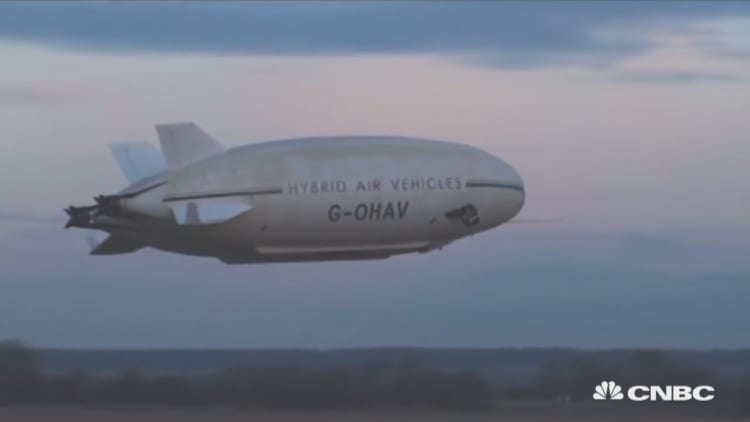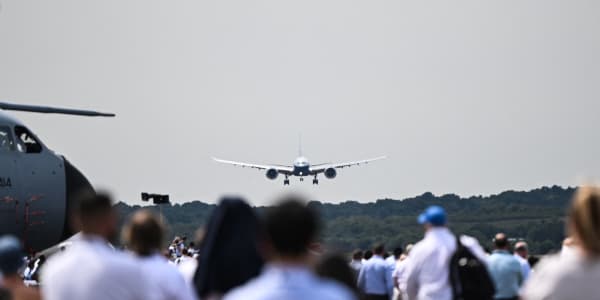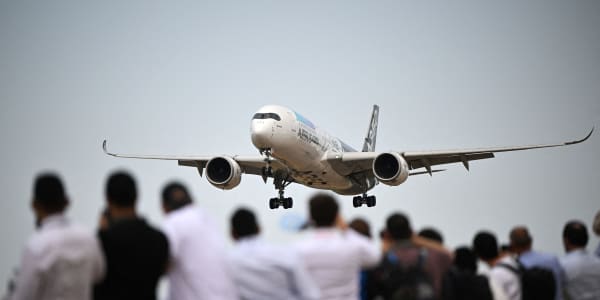Giant flying blimps - or airships - were all the rage in the period between the two world wars before a tragic disaster in the late-1930s involving an aircraft brought their popularity to an end.
Now the inflated flying structures are making a comeback with developments by the aerospace industry's biggest players and new challengers promising to develop airships for anything from luxury travel to transporting cargo to remote parts of the world.
And it could be just two years before airships begin to take to the skies for commercial use.
In a hangar nearly 60 miles north of London sits a 302 feet beast called the Airlander 10, which is vying to become a leader in an industry that could be worth $50 billion over the next 20 years, according to companies building these aircraft.
"What a hybrid aircraft can do is very efficiently carry a heavy load and that heavy load can basically be three things - people, cargo or it can be fuel - and it has ultra-long endurance," Chris Daniels, head of partnerships at Hybrid Air Vehicles, one of the companies developing an airship, told CNBC, explaining the appeal of the aircraft type.
The use cases are plenty, according to manufacturers, and could include transporting cargo for companies, surveillance, search and rescue missions, and even luxury travel. Daniels said that the passenger market is likely to remain small with the opportunity mainly in the enterprise space.
"The passenger market again is a very clear market but it's relatively niche - luxury tourism, experience flights, that kind of experience rather than getting from A to B," Daniels said.
Hybrid Air Vehicles sees a lot of opportunity in delivery of items to consumers in emerging markets where the infrastructure is poor, but users are increasingly connected through mobile devices.
"Mobile phones have managed to skip landlines in the developing world and we think in cargo, there will be no point putting in expensive roads or railways if there is an alternative," Daniels said.
Why the interest in airships?
Airships were in vogue in the period between the two world wars in the early 1900s, but quickly fell out of favor after the Hindenburg Disaster in 1937 in which the German passenger airship LZ 129 Hindenburg caught fire causing several deaths.

The incident brought an end to the airship era. But now the aircraft are making a comeback.
Behind the rising interest in airships is the aerospace's continuing drive for efficiency to reduce cost. The Airlander 10 travels at 100 miles per hour—compared to an Airbus A380's top speed of 630 miles per hour, but it is built for endurance, not needing to refuel for a long time.
And the airships are also now much safer, using helium instead of hydrogen which was used in the Hindenburg.
On top of this, new technologies are available that weren't before such as more robust material and efficient power solutions. Skeleton Technologies is one company that creates ultracapacitors - an energy storage technology backed by Tesla boss Elon Musk. Ultracapacitors are able to give a short burst of energy for situations such as stabilizing or accelerating the airship, and then can recharge in a matter of seconds and will be used in aircraft being developed by a French firm called Flying Whales.
"That's where the hybrid system comes into play. Using hybrid systems, you can downsize the engine, leading to weight and volume savings," Taavi Madiberk, CEO of Skeleton Technologies told CNBC by phone.
Oil prices
Hybrid Air Vehicles' blimp costs around $40 million to buy. As a comparison the cheapest Airbus, the A318 has an average list price of $75.1 million.
But airships face a few challenges getting off the ground and scaling. While manufacturers claim that the airships are able to land in remote areas and take off vertically, analysts said that there is no infrastructure in place to load or unload the aircraft.
And there are also concerns that the current low oil price investment could put off companies from buying the airships or using them for cargo.
"I think when you look at one of the advantages of hybrid airships, one is the cost in terms of fuel consumption, if you start to lower that whether that is in lorries, cars or marine, it will slow the commercialization of it," Glynn Bellamy, U.K. head of aerospace and defense at KPMG, told CNBC by phone.
The competition
Hybrid Air Vehicles is not the only player making airships. Lockheed Martin's LMH1 airship - which also costs around $40 million - is a competitor to Hybrid Air Vehicles with the company touting the potential to deliver cargo to remote areas. And the aerospace firm has already signed its first contract with Straightline Aviation (SLA) signing a letter of intent to purchase 12 airships, in a deal worth $480 million.
And governments are also backing the transport method. The French government recently backed a project to build an airship called the LCA60T. A Chinese state-owned enterprise called AVIC General, and a Moroccan private firm called Marita Group have also invested in the project.
The idea was born out of a problem in France's forestry industry, one of the biggest in the industry. Despite a large amount of production, there is a problem transporting wood to the mills, according to Sébastien Bougon, CEO of Flying Whales, one of the companies building the airship. He told CNBC the applications go beyond that. The LCA60T is likely to go into production in 2021 with plans for a prototype on their way.
Bougon is not concerned that a low oil price could put off investment.
"We are arriving at the right time. The forestry industry cannot afford the current solution anymore and they need a low cost solution," Bougon said.





